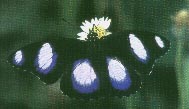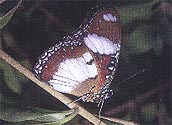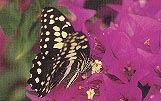by Dr. Graham R. Lobley
It may come as a complete surprise to most people to learn that the Arabian peninsula is home to more than 150 different species of butterflies. Many of these, including some of the most beautiful, can be found in the mountains and lowlands of the Hejaz and Asir Provinces in the west and southwest of the Kingdom.
 Even Jeddah boasts an excellent selection of the largest, most colourful and exotic species. The butterflies are attracted by the widespread flowering plants and shrubs present throughout the city - in residential villas, housing compounds, hotel gardens and public areas such as parks and roadside margins. Although some of these butterflies are migrants, coming to Jeddah only under favourable weather conditions, the remarkable 'greening' of the city has transformed the habitat, resulting in several species being apparently resident throughout the year. In effect, this new habitat has formed a rich oasis for butterflies as well as for other forms of natural life, such as birds.
Even Jeddah boasts an excellent selection of the largest, most colourful and exotic species. The butterflies are attracted by the widespread flowering plants and shrubs present throughout the city - in residential villas, housing compounds, hotel gardens and public areas such as parks and roadside margins. Although some of these butterflies are migrants, coming to Jeddah only under favourable weather conditions, the remarkable 'greening' of the city has transformed the habitat, resulting in several species being apparently resident throughout the year. In effect, this new habitat has formed a rich oasis for butterflies as well as for other forms of natural life, such as birds.
There are many intriguing and unique aspects to butterflies. The tiny scales on butterflies' wings are individually coloured and make up the particular wing patterns of each species, thus forming some of the most beautiful patterns to be found in the natural world.
Two of the most colourful butterflies, the Plain Tiger Danaus chrysippus and the Diadem Hypolimnas misippus also have remarkably fascinating life styles. The caterpillar of the Plain Tiger feeds on plants of the milkweed family, such as Calotropis procera, which is common all along the Tihama coastal plains. The milkweed food plant contains cardiac toxins and these are transferred to the tissue of the adult butterfly. These toxins afford excellent protection against attack from vertebrate predators, such as birds and lizards.
The female Diadem has evolved into a near-perfect copy of the Plain Tiger, thus escaping attack from predators that already know from bitter experience to avoid the Plain Tiger. Entomologists call species which copy others mimics. So visually indistinguishable are the model and mimic that even the male Diadem is sometimes fooled by a passing specimen of Plain Tiger and may spend some time courting an individual of the wrong species! The male Diadem is a very attractive butterfly, which has a quite different appearance. The male has jet black wings with prominent white egg-shaped spots, which are fringed with brilliant purple.
The large African Lime Papilio demodocus is another striking butterfly which is common in Jeddah and in the greener wadis in the foothills and mountains. This exotic species is common throughout tropical Africa, where it can even become a pest as the primary food plant of the caterpillars are the leaves of citrus trees. It is often seen in Jeddah's gardens where a favourite flower is the bougainvillea, which is a widespread and colourful component of most green areas.
 The drier Tihama lowlands are normally a less productive butterfly habitat. Some species of 'Whites' such as the Yellow Patch White Colotis halimede are adapted to these more arid areas and range across Africa's Sahel, south of the Sahara Desert. This species often settles on bare earth. Strong migrant butterflies such as the Caper White Anaphaeis aurota and Painted Lady Vanessa cardui can sometimes be seen on the Tihama in large numbers. The Caper White is a distinctive black-patterned white, which ranges across the whole of the Arabian peninsula and migrants sometimes reach the Eastern Mediterranean. In Spring, I enjoyed seeing large numbers avidly feeding on the nectar of magenta coloured Limonium flowers right by the Red Sea. The Painted Lady is easily the world's most widely distributed butterfly, reaching all continents except Antarctica. A powerful migrant, I once witnessed huge numbers of this species passing up a scarp wadi, following a period of good winter rains.
The drier Tihama lowlands are normally a less productive butterfly habitat. Some species of 'Whites' such as the Yellow Patch White Colotis halimede are adapted to these more arid areas and range across Africa's Sahel, south of the Sahara Desert. This species often settles on bare earth. Strong migrant butterflies such as the Caper White Anaphaeis aurota and Painted Lady Vanessa cardui can sometimes be seen on the Tihama in large numbers. The Caper White is a distinctive black-patterned white, which ranges across the whole of the Arabian peninsula and migrants sometimes reach the Eastern Mediterranean. In Spring, I enjoyed seeing large numbers avidly feeding on the nectar of magenta coloured Limonium flowers right by the Red Sea. The Painted Lady is easily the world's most widely distributed butterfly, reaching all continents except Antarctica. A powerful migrant, I once witnessed huge numbers of this species passing up a scarp wadi, following a period of good winter rains.
Most butterflies are especially attracted to feeding on flower nectar and several larger Afrotropical species are relatively easily seen in Jeddah's more luxuriant and established gardens. The best natural habitats for butterflies in Saudi Arabia are the southwestern mountain wadis, which have a relatively wide variety of green vegetation and flowers, especially after good winter rains. Such locations have the largest number of species. It is not uncommon to see around twenty different species in particularly productive habitats. As butterflies are heavily dependent on flowers and caterpillar food plants, these sites are also very rich in natural flora. Some of the best areas of all are in the verdant wadis beneath the towering escarpment mountains, west of Abha in Asir. These wadis benefit from a relatively regular and periodic rainfall pattern on the escarpment mountains.
 The rich wadis and surrounding hill sides are home to the exciting Acraeas and Charaxes butterflies. Acraeas are attractive butterflies with rich tawny wings with black spots and wing borders. In some ways superficially resembling the fritillaries of more temperate climates, such as Europe, Acraeas are Afrotropical species with an elegant, strong flight. Doubleday's Acraea Acraea doubledayi often glides for considerable distances on fully extended wings, in between powerful wing beats.
The rich wadis and surrounding hill sides are home to the exciting Acraeas and Charaxes butterflies. Acraeas are attractive butterflies with rich tawny wings with black spots and wing borders. In some ways superficially resembling the fritillaries of more temperate climates, such as Europe, Acraeas are Afrotropical species with an elegant, strong flight. Doubleday's Acraea Acraea doubledayi often glides for considerable distances on fully extended wings, in between powerful wing beats.
Butterflies in Saudi Arabia can sometimes be seen feeding in the moist sediments near water, supplementing their regular diet with additional minerals. Some species, such as Charaxes rarely feed on flower nectar, preferring rotting fruit or meat. The unmistakable Cream Bordered Charaxes Charaxes hansali has two prominent tails on each hind wing and a beautifully marbled underside wing pattern. This striking large butterfly ranges through parts of East Africa into southwestern Arabia and there is also a distinct subspecies which is limited to the scarp slope of the Dhofar mountains of Oman. This butterfly has a powerful flight and is usually very wary. Consequently, I was elated when a perfect specimen once landed on a friend's clothing, perhaps attracted by the pattern and colour.
As long as favourable habitats remain, or arise temporarily, the gorgeous butterflies to be found in western Saudi Arabia will continue to provide strong interest and enjoyment for keen butterfly watchers.
| Subjects | Search
Arabian Wildlife. Volume 3, Number 2